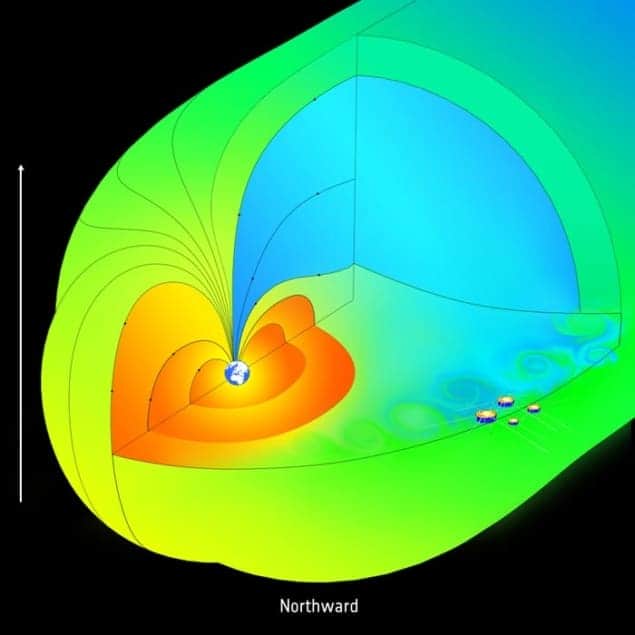
The Earth’s magnetic field is more permeable than previously thought, according to researchers analysing data from the European Space Agency’s Cluster mission. The findings have implications for modelling the dangers posed by space weather and could also help us better understand the magnetic environments around Jupiter and Saturn.
The Cluster mission, launched in 2000, comprises four identical satellites flying in a tetrahedral formation in close proximity to Earth. With highly elliptical orbits, the satellites are able to sweep in and out of the Earth’s magnetic environment, building up a 3D picture of interactions between the solar wind and our planet. The solar wind is a stream of charged particles from the outer layers of the Sun blowing into the solar system. The Earth’s magnetic field is thought to form a protective barrier against it.
It is well known, however, that if the magnetic field of the incoming solar wind has the opposite orientation to the Earth’s magnetic field, then the field lines can break and join up again in a process known as “magnetic reconnection”. This process allows the plasma from the solar wind to breach the boundary of the Earth’s magnetic field – the magnetopause – where it can then potentially reach our planet.
Swirling vortices
In 2004 data from Cluster revealed that this mismatch in magnetic orientation was not a hard and fast rule – 40,000 km-long swirls of plasma were spotted along the magnetopause, creating gateways into the magnetosphere even when the two magnetic fields were aligned. By 2006, researchers had concluded that these vortices were likely caused by Kelvin–Helmholtz waves (KHWs), occurring when two mediums are flowing on either side of a boundary at different velocities. An earthly example is wind blowing over the boundary between the air and the ocean. In space, the boundary is the magnetopause, with the decelerated plasma on the Earth-side travelling slower than the solar-wind plasma beyond.
Once created, the amplitude of these instabilities can build up, tangling the magnetic field lines and triggering magnetic reconnection despite the field lines being aligned. This phenomenon was only thought to happen under special conditions, however. “We thought [it] was restricted to areas around the Earth’s equator,” Arnaud Masson, one of the scientists working on the Cluster mission, told physicsworld.com. Now, new analysis of Cluster data, initially obtained in 2003, shows the same thing happening at much higher latitudes, and at a wider range of magnetic-field alignments. “It seems that no matter what the orientation of magnetic fields, the same effect can occur,” explains Masson. “It appears that it happens all the time, rather than just in special circumstances.”
Modelling space weather
Knowing the range of conditions under which the solar wind can penetrate the Earth’s magnetic defences plays an important role in modelling space weather – a catalogue of effects including disruption to GPS navigation caused by interaction with the solar wind. “You have to know where the doors are open in our protective shield,” explains Masson. Chris Arridge, of University College London, agrees. “It seems there are a lot more holes in the Earth’s magnetic sieve than we thought,” he says. “If we want to develop the ability to predict space-weather effects, then it is important to know the full range of ways that energy, mass and momentum can get into the system.”
Arridge, a researcher on the interaction between the solar wind and the outer planets of the solar system, believes this line of research could also help us understand Jupiter and Saturn. “The exact role of KHWs in the magnetospheres of the giant planets is a hot topic,” he reveals. Understanding the Earth’s KHW mechanisms will help us understand Jupiter and Saturn’s magnetic environments and vice versa.”
The research is published in Journal of Geophysical Research.



